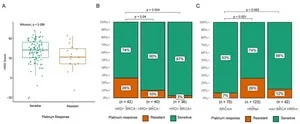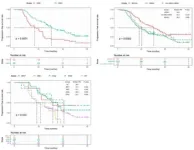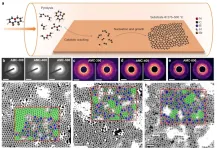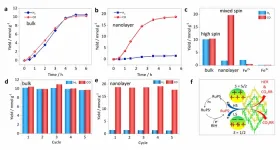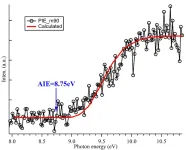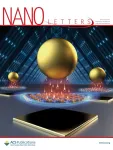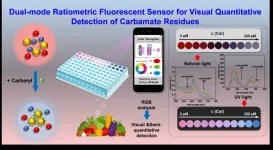(Press-News.org) Raman imaging offers a greater potential for detecting multiple enzyme activities than fluorescence imaging, demonstrate Tokyo Tech researchers by developing 9CN-rhodol-based activatable Raman probes using a novel mechanism for Raman signal activation. The strategy allows a synthesis of highly activatable Raman probes with high aggregation and multiplexing ability, making it a promising tool for extending the range of Raman probes for the detection of multiple enzyme activities in heterogeneous biological tissues.
The involvement of enzymes in a wide range of biological activities makes them ideal biomarkers for the detection of diseases. In fact, cancer-specific diagnostic technologies use fluorescence imaging for detecting upregulated cancer-associated enzymes in the affected cells. Moreover, since tumor tissues are heterogenous, detecting multiple enzyme activities simultaneously could allow precise cancer visualization and diagnosis. However, the inability to detect multiple enzyme activities can potentially limit the application of fluorescence imaging in heterogeneous tumor tissues and other complex biological phenomena.
As an alternative, the narrower spectral width of Raman spectral imaging offers hope for multiplexing biological imaging with molecular probes. Over the years, several functional and activatable Raman probes (dyes) for detecting bioanalytes have been developed, but those for detecting enzyme activities have been limited. Further, the previous design strategies have failed to control the diffusion of enzyme-generated hydrolysis product of these probes, making it difficult to distinguish regions with target enzyme activity in tissues.
Against this backdrop, a team of researchers from Japan led by Professor Mako Kamiya and Assistant Professor Hiroyoshi Fujioka of Tokyo Institute of Technology (Tokyo Tech) recently reported, taking inspiration from aggregation-based fluorescent probes, a new molecular design strategy for the synthesis of activatable Raman probes based on 9CN-rhodol. Their study was published in the Journal of the American Chemical Society.
Explaining the choice of rhodol derivatives for molecular scaffold, Prof. Kamiya says, “Hiroyoshi found that rhodol derivatives with a nitrile group at the ninth position (9CN-rhodols) and a net charge of zero exhibit a single sharp Raman peak and have higher aggregation ability in aqueous solution than 9CN-pyronins with positive charge. Accordingly, we used 9CN-rhodol scaffold dyes to create Raman probes that can exhibit high sensitivity and undergo red shift in molecular absorption towards a region of resonant Raman effect and form aggregation upon interacting with the target enzymes .”
Accordingly, the team first synthesized 9CN-rhodol derivatives and selected two derivatives, 9CN-JR and 9CN-JCR, as candidates for designing the activatable Raman probes. They then tested the enzyme detection performance of both probes in live cells using a dual-color stimulated Raman scattering (SRS) imaging technique. Of the two, 9CN-JCR emerged as the better and brighter probe for multiplexing.
Next, the team isotope-labeled the nitril group of 9CN-JCR scaffold with Carbon-13 (13C) and Nitrogen-15 (15N) and then created two new isotope edited 9CN-JCR probes for γ-glutamyl transpeptidase and dipeptidyl peptidase-4 enzymes. The new set of 9CN-JCR-based probes was then able to simultaneously detect the activities of all these enzymes in the live cell culture.
Moreover, the probes allowed ex vivo imaging of distinct cell regions expressing target enzyme activity in Drosophila wing disk and fat body. The high spatial selectivity and sensitivity exhibited by the 9CN-JCR probes was attributed to the electronic pre-resonance effect of the scaffold dye and aggregate formation of the hydrolysis products formed by probe-target cell interaction.
The rhodol-based probes could aggregate upon reaction with the enzymes, improving their intracellular retention, and increased the SRS signal intensity during enzyme detection.
In summary, the facile strategy demonstrated in this study can facilitate the development of highly specific activatable Raman probes for the simultaneous detection of multiple enzyme activities. “Our aggregation-based molecular design strategy for Raman probes will offer substantial advantages for applications involving the investingation of enzyme activity associated with diseases and essential biological activities,” concludes Prof. Kamiya.
This project was conducted in collaboration with Prof. Yasuyuki Ozeki at The University of Tokyo.
###
About Tokyo Institute of Technology
Tokyo Tech stands at the forefront of research and higher education as the leading university for science and technology in Japan. Tokyo Tech researchers excel in fields ranging from materials science to biology, computer science, and physics. Founded in 1881, Tokyo Tech hosts over 10,000 undergraduate and graduate students per year, who develop into scientific leaders and some of the most sought-after engineers in industry. Embodying the Japanese philosophy of “monotsukuri,” meaning “technical ingenuity and innovation,” the Tokyo Tech community strives to contribute to society through high-impact research.
https://www.titech.ac.jp/english/
END
In Japan, many municipalities have suffered from population decline due to low birth rates and an aging population. In 2022, the Japanese population over the age of 65 was 36.21 million, accounting for 28.9% of the total population. In addition, approximately 1,300 shrinking cities are within the 1,700 municipalities in Japan. Moreover, the large number of shrinking cities in Japan is unprecedented on a global scale. As a response to the low birthrate, the Japanese government is discussing “unprecedented” measures to reverse the decline, such as ...
A new Cochrane Review led by an Upstate Medical University professor has found that, compared with standard antibiotic treatment, stool transplantation can increase the number of people recovering from Clostridioides difficile (C. diff) infection, a condition which causes potentially life-threatening diarrhea. 77 percent of people who received a stool transplant did not experience reinfection within eight weeks, compared to 40 percent of those who received antibiotics alone.
C. diff is a bacterium that can cause life-threatening diarrheal illness in individuals ...
Poor air quality linked to cognitive problems in babies
Poor air quality could be causing cognitive deficits in babies and toddlers, according to new research from the University of East Anglia.
A new study published today reveals an association between poor air quality in India and impaired cognition in infants under two.
Without action, the negative impact on children’s long-term brain development could have consequences for life.
Lead researcher Prof John Spencer, from UEA’s School of Psychology, said: “Prior work has shown that poor air quality is linked ...
During the peak of the Covid-19 pandemic, a constant public fear was the rise of a new variant of the disease. Among the countless possibilities of a SARS-CoV-2 viral mutation, some were really alarming, such as Omicron, Delta, and Gamma. The strains with greater virulence and ability to invade the immune system are defined as variants of concern (VOCs), since they also have the potential to overwhelm the health system, increasing the number of admissions to intensive care units (UTIs). Recently published in the Intensive ...
Genetic markers such as fragment length polymorphisms (RFLP), simple sequence repeat (SSR), and single-nucleotide polymorphisms (SNPs) provide unique identifiers for individual organisms. This aids the identification of significant genetic variations in plants, allowing modern plant breeding to select superior crop varieties. Next-generation sequencing (NGS) has enhanced marker-assisted selection or backcross breeding of crops, which is the transfer a desired trait such into the favored genetic background of another.
However, due to its expensive nature and extensive data processing requirements, NGS is not practical for screening large populations ...
Recently,Prof. LIU Lei's group from Peking University,the user of the Steady-state High Magnetic Field Experimental Facility (SHMFF), Hefei Institutes of Physical Science (HFIPS) of Chinese Academy of Sciences (CAS), together with Prof. WANG Zhaosheng from High Magnetic Field Center, HFIPS of CAS and other co-authors revealed the structure-property relationship in 2D amorphous materials for the first time by the study of amorphous monolayer carbon (AMC).
The relevant research was published in ...
Recently, Professor WU Dayu of Changzhou University, the user of China's Steady High Magnetic Field Facility (SHMFF), Hefei Institutes of Physical Science (HFIPS) of the Chinese Academy of Sciences (CAS), together with his collaborators proposed a facile mechanical strategy to optimize the electronic structures of the catalytic center by mechanically induced spin transition, and realized a new method for designing efficient biomimetic catalysts.
The results were published in Angewandte Chemie International Edition.
In recent years, the synthesis of transition-metal catalysts has received extensive attention. ...
Organic peroxy radicals (RO2) are important intermediates in the degradation of atmospheric volatile organic compounds (VOCs). RO2 not only participates in the chain cycles of atmospheric radicals and influences oxidizing capacity of the atmosphere, but also controls the formation of secondary pollutants. Under low NOx conditions, peroxy radicals react mainly with HO2 radicals, as well as with themselves, and their products tend to have low volatility easily entering the particulate phase. However, the associated double radical ...
A research team led by Prof. YANG Liangbao from Hefei Institutes of Physical Science, Chinese Academy of Sciences found that hexagonal boron nitride (h-BN) could effectively block electron tunneling and extend the ultimate plasmonic enhancement limits in a single-atom-layer gap, providing deep insights into quantum mechanical effects in plasmonic systems and enabling potential novel applications based on quantum plasmonics.
The results were published in Nano Letters.
The team have been working on developing surface-enhanced ...
A team of researchers led by Prof. JIANG Changlong from Institute of Solid State Physics (ISSP), Hefei Institutes of Physical Science of of Chinese Academy of Sciences developed a new sensing system for detecting carbaryl residues.
The research findings have been published in ACS Sustainable Chemistry & Engineering.
Carbaryl is a widely used insecticide that can easily enter the body through respiratory intake and dermal contact, resulting in serious health hazards, including carcinogenicity and reproductive abnormalities. Therefore, it is crucial to detect carbaryl residues in environmental and food samples. However, ...

